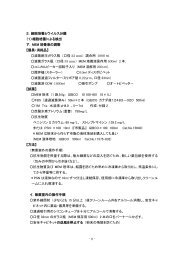Program and Abstracts(PDF)
Program and Abstracts(PDF)
Program and Abstracts(PDF)
You also want an ePaper? Increase the reach of your titles
YUMPU automatically turns print PDFs into web optimized ePapers that Google loves.
Satellite symposium 1<br />
ARTIFITIAL COMPLETION OF THE JAPANESE EEL, ANGUILLA JAPONICA,<br />
LIFE CYCLE: CHALLENGE TO MASS PRODUCTION<br />
Yoshitsugu Masuda 1* , Hitoshi Imaizumi 1 , Kentaro Oda 1 , Hiroshi Hashimoto 1 , Hironori<br />
Usuki 1 , <strong>and</strong> Kazuhisa Teruya 2<br />
1 Shibushi Station, National Center for Stock Enhancement, Fisheries Research Agency,<br />
Shibushi, Kagoshima 899-7101, Japan<br />
2 Stock Enhancement Technology Section, Ishigaki Tropical Station, Seikai National Fisheries<br />
Research Institute, Fisheries Research Agency, Ishigaki, Okinawa 907-0451, Japan<br />
* Email: masuday at affrc.go.jp<br />
Development <strong>and</strong> modification of slurry type diets made from shark-egg powder have enabled<br />
glass eel production in captivity by the group of Dr. Tanaka in National Research Institute of<br />
Aquaculture 1-3) . Based on this success, recent investigations have specifically examined<br />
establishment of techniques for consistent mass production of glass eels. Now, there are many<br />
problems to settle in rearing eel larva, leptocephalus. The current procedures of feeding <strong>and</strong><br />
maintenance are too troublesome for application to mass rearing. In addition, rearing period is<br />
too long <strong>and</strong> can not be correctly estimated. Moreover, limited supply of diet material,<br />
shark-egg, cannot meet mass production of glass eels. To overcome these problems, we<br />
suggested colloid-type diet <strong>and</strong> try to develop automatic system of rearing procedures. We<br />
also try to develop the diets made from new materials besides shark-egg. Then we succeeded<br />
shortening the rearing period from egg to glass eels. In our presentation, we would introduce<br />
these challenges to achieve mass production.<br />
Annotated Bibliography of Key Works<br />
1) Tanaka, H., H. Kagawa, <strong>and</strong> H. Ohta. 2001. Production of leptocephali of Japasese eel,<br />
Anguilla japonica, in captivity. Aquaculture 201. 51-60.<br />
Despite intensive research on wild <strong>and</strong> captive eels, no resource has so far provided access to<br />
all life cycle stages of the Japanese eel Anguilla japonica. The transition from the<br />
preleptocephalus, newly hatched larva, to the leptocephalus stage, typical leaf-like eel larva,<br />
has, therefore, remained the missing link in the eel life cycle. We recently found that a<br />
slurry-type dit made from shark egg powder is suitable feed for captive-bred eel larvae. The<br />
larvae were successfully reared with this diet in aquaria for 100 days <strong>and</strong> raised to 22.8 mm in<br />
total length, TL. Age, RL, <strong>and</strong> body proportions of the reared specimens overlapped with<br />
those of wild leptocephali. We revealed for the first time the transition from the<br />
preleptocephalus to the leptocephalus stage of the eel.<br />
2) Tanaka, H., H. Kagawa, H. Ohta, T Unuma, <strong>and</strong> K. Nomura. 2003. The first production of<br />
54



